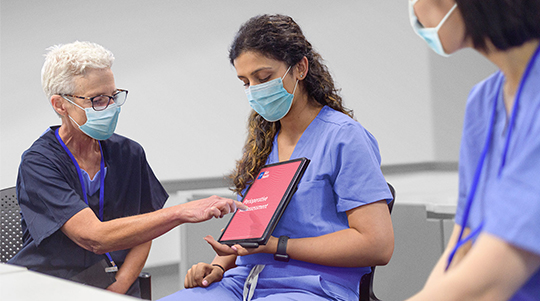Reduce administrative task burdens to help fight nurse burnout
How to help make clinical documentation less stressful.

Patient documentation was recorded on paper forms for a long time. When someone wanted to add or change a form, it meant reprinting thousands of copies, which meant it didn’t happen very often.
Then, electronic health records (EHR) were introduced.
For the past several decades, electronic health records have been a critical component to healthcare coordination, pressure injury prevention and general patient care. They make it easy to revise form fields, update patient information and consolidate data in one place. However, over the years, EHRs have increased in size and led to some unintended drawbacks.
One of the biggest challenges for healthcare professionals at nearly every level of care is the administrative burden and usability issues that come with completing patient documentation. It’s a task many caregivers see as tedious, taking them away from their passion: caring for the patient.
The stress associated with all this paperwork can contribute to high levels of nursing burnout.
Data from one large EHR vendor shows that patient admission documents have as many as 950 questions.¹ What does that mean in terms of time? Studies show nurses spend as much as 50% of their time on clinical documentation demands.²
950+
Patient admission document questions¹
50%
Nursing time spent on documentation²
Working to change the model
“This is something that needs to be solved quickly because it’s impacting nurses as we speak,” says Sarah Rossetti, RN, PhD, FAAN, FACMI, FAMIA Associate Professor of Biomedical Informatics and Nursing, Columbia University Medical Center. Dr. Rossetti is among a group of people who developed the 2021 25 by 5: Symposium to Reduce Documentation Burden on U.S. Clinicians by 75% by 2025.
In the 25 by 5 executive summary, the authors maintain that the documentation burden “stems from a misalignment between electronic health record (EHR) usability, ever-evolving clinical and regulatory demands, and clinician satisfaction related to entering and using EHR data.”³
In addition to the significant clinician burnout, this burden can lead to decreased job satisfaction, medical errors and patient injury.³
There are many factors that contribute to documentation burden. One of the aspects is that EHRs are configured at the local level and new data elements are added overtime but rarely taken away, Dr. Rossetti explains. In other words, large-scale efforts to consolidate data are hard to achieve because data entry forms vary from facility to facility.
“One part of the solution are common data models that define essentially what should be recorded based on best practices and not based on including information that’s excessive,” Dr. Rossetti says.
In addition to clinician burnout, the EHR burden can lead to decreased job satisfaction, medical errors and patient injury.³ The goal of the 25 by 5 symposium is to come up with a plan to reverse this trend.
What you can do now to decrease task overload
There are several policy and vendor changes that need to occur for sustainable long-term results. In addition, “To effectively decrease documentation burden immediately, health systems can tackle what we call, the ‘We’ve done it to ourselves’ problem,” Dr. Rossetti says.
By this, Dr. Rossetti means that the answer will truly come from within.
Every facility needs to look at the data they’re collecting, flow sheet row by flow sheet row, ensuring each item has a purpose, answering questions such as:
- Why do we capture this?
- Does it need to be captured?
- Does it have a clear, current regulatory requirement?
- Did we add this field years ago for a regulatory requirement that’s no longer relevant?
- Can we trace this back to a patient safety reason?
- Is this recorded for important clinical information we need to share?
Verify what’s needed and then start to remove what’s not.
“When we remove burdensome information that doesn’t provide extra clinical value, nurses have the autonomy they need to provide their professional judgment.”

Sarah Rossetti
RN, PhD, FAAN, FACMI, FAMIA
Empower caregivers in 3 ways
If you’re thinking you and your team have no control over this documentation review, consider the crucial role you all play in patient care.
You can help drive down administrative burdens and usability issues by empowering frontline nurses to do 3 things:
- Voice their concerns. “Nurses often feel as though any information presented on a form must be completed,” Dr. Rossetti says. That’s not always the case, but it’s not always clear. “It’s a conversation to have on the clinical unit level and other governance levels.” Let caregivers know it’s OK to look critically at the data being requested and the EHR workflows and design. If a form item doesn’t seem to support patient care or is not easy to use, they should feel comfortable asking why it’s there and how it could be redesigned.
- Participate in change. When caregivers feel burdened, stressed and anxious about the heavy load of documentation, help redirect them to positive action. “Those nurses should be engaged by the health system as decisionmakers, and that includes standing on committees to reduce documentation burden,” Dr. Rossetti emphasizes.
- Trust their judgment. In her research outside of documentation burden, Dr. Rossetti has shown that nurses intuitively understand which patient data is valuable to help support delivery of care. “When we see there’s an increased level of documentation by nurses for a patient, it means they may be worried about that patient,” she explains.
Through that extra attention, Dr. Rossetti says, “We can predict patients deteriorating in the hospital about 40 hours earlier than other early measurement tools.” Because nurses know their patients so well, “They’re not waiting for requirements.”The point is, Dr. Rossetti says, “When we remove burdensome information that doesn’t provide extra clinical value, nurses have the autonomy they need to provide their professional judgment.”
Success story: Project Joy reduces administrative burden and saves money
When UCHealth in Aurora, Colorado, decided to address their administrative burden, they focused on the “self-imposed part of burden,” explains Bonnie Adrian, PhD, RN-BC, Research Nurse Scientist, Clinical Informatics. During a 25 by 5: Symposium talk, Dr. Adrian described their situation, their process to change and their impressive results two years after they launched what they called Project Joy.4
The situation: Dr. Adrian compares their previous documentation to an overflowing, messy, unorganized closet.
The process: They developed guiding principles and inclusion criteria for nursing documentation; created dedicated committees; and reviewed each flow sheet row as if it were an item in the closet. Did it spark “joy,” as Marie Kondo might ask? Or, in their case, did it add value to patient care.
Results within two years: Better functionality, improved patient-centered flow sheet experience for the RN–and increased joy.
Results by the numbers
- 496 flow sheet rows eliminated
- 18 fewer minutes spent in flowsheets per inpatient RN 12-hour shift
- 64,800 RN hours added back to patient care
- $2.8 million saved
4 success factors from Project Joy
- Involve the chief nursing executive
- Make resources available
- Pare down the focus for the first year, even if it means new documentation becomes temporarily out of alignment with old flow sheets
- Develop and engage all groups: Clinical subject matter experts; “guardrails,” meaning legal, quality, regulatory and reps from various certification programs; senior leaders; design team, including clinical informaticists; digital builders; and an overall coordinator
Shift the mindset to refocus on the patient
Changing your facility’s electronic health records may take some time depending on variables such as the size of the health system and support from leadership. But you can still help caregivers take important steps to managing documentation overload. Here are some ways to do that:
Make it positive. At least some of the data collection happens while a patient is present. This may leave patients feeling ignored—even if that’s not the case, but it seems that way because the nurse is looking at the screen. Instead, caregivers might explain to patients why they’re in front of the computer. For example, telling patients, “I’m still listening while I’m entering this data, because I want to make sure I have all the right information to provide you the best care possible. And so that the next clinician who sees you knows what we talked about and what we did.”
“Remember that this is the record of your patients and your interventions.”

Patricia Turner
BSN, RN, CWOCN, CWS, Medline Director of Clinical Resources Skin Health
Make it count. “What we don’t want happening is the nurse skipping or skimping on documentation,” says Patricia Turner, BSN, RN, CWOCN, CWS, Medline Director of Clinical Resources Skin Health. Also, be sure you and your team know how to use the EHR system at your facility. “Don’t wing it,” Turner says. “Know what screen leads to the next and what’s required. If there’s something you don’t know, request training. The more familiar you are with the system, the quicker it gets.”
Make it personal. “Remember why you’re doing all this,” Turner says. “Remember that this is the record of your patients and your interventions.” Instead of thinking about it as a necessary evil, think about it as representing your patient and enabling you and your team to provide the best care possible.
Key takeaway
Nurse burnout has many contributing factors, including the process of patient documentation in electronic health records. Although this task stemmed from good intentions, it has created some administrative burdens. That’s why it’s important to encourage caregivers to shift their mindsets, reminding them that the EHR helps them care for their patients. You may also empower them to speak up if a form question seems unnecessary, participate in improving electronic health records, and continue to use their expert judgment for patient care.
References:
- 25×5: Cognitive Burden (Sherri Hess, MS-IS, BSN, RN-BC, FHIMSS). (2021, January 18). [Video]. YouTube. https://www.youtube.com/watch?v=jgnWFymj074
- TMF Health Quality Institute, Russell, K., Calderon, K., Daly, S., & Hanson, C. (2018, May). Reducing Administrative Burden: Refocusing on Patient Centric Care. https://www.tmf.org
- 25 By 5: Columbia Leads Symposium, Ongoing Efforts to Reduce Documentation Burden on U.S. Clinicians. (2022, May 13). Columbia DBMI. https://www.dbmi.columbia.edu/25×5/
- 25×5: Project JOY (Bonnie Adrian, PhD). (2021, January 31). [Video]. YouTube. https://www.youtube.com/watch?v=QXw4p8wdlWs




